Program
11/10 Friday
| Day-1 | Friday, Nov 10th, 2017- Performing Center, First Teaching Building 第一教學大樓B1演藝廳 |
|
| 08:40-09:00 | Registration | |
| Opening Session: Introductory Speech | ||
| 09:00-09:10 |
Innovative Research and Social Contribution at KMU's Research Center for Environmental Medicine: Achieving Excellence Ming-Tsang Wu 吳明蒼, M.D., Sc.D., MOH |
|
| Opening Remarks | ||
| 09:10-09:25 |
Ching-Kuan Liu 劉景寬 Jung-Yaw Lin 林榮耀 Hsin-Su Yu 余幸司 |
|
| Honorary Speech | ||
| 09:25-09:35 |
Security and Use of Food Additives Fang-Ming Liu劉芳銘, M.D. |
Moderator Ching-Kuan Liu 劉景寬, |
| 09:35-09:55 | Group Photo / Coffee Break | |
| Session 1: Food Safety | ||
| 09:55-10:30 |
New Biospecimens and Mass Spectrometry-Based Approaches to Biomonitor Exposures to Environmental and Dietary Carcinogens Robert Turesky, B.Sc., Ph.D. |
Moderator Wen-Jeng Wu 吳文正,
Moderator Jaw-Yuan Wang 王照元, |
| 10:40-11:15 |
Diabetic Pregnancy Impact on Your Kidney as a Fetus and Beyond Shao-Ling Zhang, Ph.D. |
|
| 11:25-11:50 |
21st Century Toxicology Strategy for Food Safety Assessment Pin-Pin Lin 林嬪嬪, Ph.D. |
|
| 12:00-13:15 | Lunch | |
| Session 2: Environmental Endocrine Disruptor | ||
| 13:15-13:40 |
The Effects of Phthalate Metabolites on Testicular Function in Male Adult Ching-Chang Lee 李俊璋, Ph.D. |
Moderator Joh-Jong Huang 黃志中,
Moderator Ming-Feng Hou 侯明鋒, M.D. |
| 13:50-14:15 |
Endocrine Disrupting Chemicals: Perfluoroalkyl Substances Pau-Chung Chen 陳保中, M.D., Ph.D. |
|
| 14:25-15:00 |
DNA Nanotechnology and it's Medicinal Applications Arivazhagan Rajendran, Ph.D. |
|
| 15:10-15:30 | Coffee Break | |
| Session 3: Atmospheric Pollution | ||
| 15:30-16:05 |
Trends in Human Exposure to Air Pollution (PM2.5) in Madrid (2000-2009): Spatial Distribution, Health Effects and Economic Quantification Germán Orrego, Ph.D. |
Moderator Pau-Chung Chen 陳保中,
Moderator Eing-Mei Tsai 蔡英美, |
| 16:15-16:40 |
Exposure Assessment of Atmospheric Pollutants from Industrial and Urban Sources Chon-Lin Lee 李宗霖, Ph.D. |
|
| 16:50-17:30 | Student Forum (I) 4 presenters:10min (Each presenter will have eight minutes for presentation and two minutes for comments) |
Moderator Chien-Hung Lee 李建宏, Ph.D.
Moderator Jau-Ling Suen 孫昭玲, Ph.D.
|
11/11 Saturday
| Day-2 | Saturday, Nov 11th, 2017-A1 Room, Li-Hsueh Building 勵學大樓1樓半A1教室 |
|
| 08:40-09:00 | Registration | |
| Session 1: Air Pollution and Public Health | ||
| 09:00-09:35 |
The Effect of Climate Change on the Occurrence of Occupational and Environmental Asthma David Christiani, M.D., MPH, M.S. |
Moderator Yue-Liang Guo 郭育良,
Moderator Inn-Wen Chong 鍾飲文,
|
| 09:45-10:20 |
Biomass-burning Air Pollution and Health Risk among Northern Thai Population Tippawan Prapamontol, Ph.D. |
|
| 10:30-10:50 | Coffee Break | |
| 10:50-11:15 |
The Effect of Air Pollutants on Chronic Airway Diseases in Taiwan Chau-Chyun Sheu 許超群, M.D. |
Moderator Tusty-Jiuan Hsieh 謝翠娟,
Moderator Chun-Hsiang Tan 譚俊祥, |
| 11:25-12:05 | Student Forum (II) 4 presenters:10min (Each presenter will have eight minutes for presentation and two minutes for comments) |
|
| 12:05-13:15 | Lunch | |
| Session 2: Drug, Chemical and Environmental Issues | ||
| 13:15-13:50 |
World-Class New Drug Discovery and Development from Toxic Compounds Found in Chinese Herbal Medicine Kuo-Hsiung Lee 李國雄, Ph.D. |
Moderator Hsin-Su Yu 余幸司,
Moderator Yang-Chang Wu 吳永昌, Ph.D. |
| 14:00-14:35 |
Our Search for the Holy Grail in Pain Management Horace H. Loh 羅浩, Ph.D. |
|
| 14:45-15:10 |
Near-Infrared Radiation Induces an Anti-Inflammatory M2 Macrophage Polarization Via Epigenetic Regulation of the Mitochondrial Citrate Synthase Gene Wei-Ting Liao 廖偉廷, Ph.D. |
|
| 15:20-15:40 | Coffee Break | |
| 15:40-16:05 |
Rapid Diagnosis of Drug Abuse Bai-Hsiun Chen 陳百薰, M.D., FCAP. |
Moderator Jen-Taie Shiea 謝建台, Ph.D. |
| 16:15-16:40 |
A Robust Tool for Rapid Identification of Occupational Skin Exposure to Pesticides and Confirmation of Adequate Dermal Decontamination Chi-Wei Lee 李啟偉, M.D., M.Sc., Ph.D. |
|
| 16:50-17:00 | Awards Ceremony |
Moderator Yau-Huei Wei 魏耀揮, Ph.D.
Ming-Tsang Wu 吳明蒼,
|
Invited Speakers
International Speakers
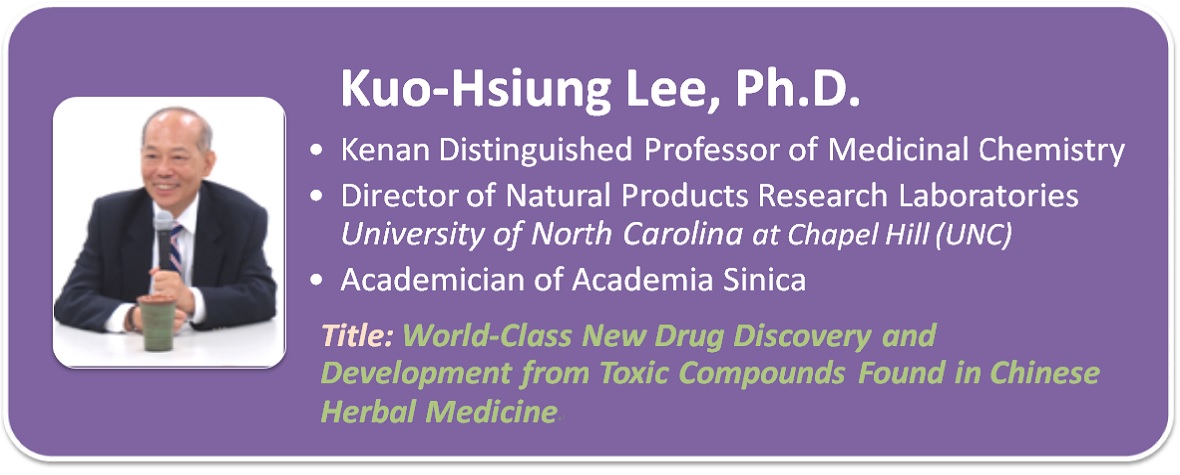
Abstract
Western and Chinese medicine vary in theory, practice, and drugs of choice. Western medicine primarily uses pure natural or synthetic compounds aimed at a single target. However, Chinese Herbal Medicine (CHM) uses processed multicomponent natural products, in various combinations and formulations aimed at multiple targets, based on therapeutic effects and the body’s reactions to herbal products. In the classic Chinese compendium, Shen Nung Pen Tsao Ching, Shen Nung recorded 365 herbs classified as Upper Class (nontoxic and rejuvenating), Middle Class (nontoxic or toxic effects and may need more precaution), and Lower Class (toxic effects and are used in formulations only after proper processing and in proper combinations to reduce their toxicity).
However, the aforementioned lower class “most toxic” herbs, as well as other toxic plants used in folkloric medicine, can often serve as excellent sources of potential new Western drugs. By using medicinal chemistry approaches coupled with cutting-edge life science technologies, the active principles can be isolated and characterized as new leads. The selected new leads can then be optimized through structure modifications and mechanism of action studies to yield promising candidates. Preclinical studies, which involve in vivo efficacy and toxicity evaluations, as well as production and formulation, further develop the candidate compounds in preparation for clinical trials as potential world-class drugs.
This talk will illustrate many toxic compounds, which were developed for clinical uses, clinical trials, and preclinical studies from CHM, especially examples discovered as anticancer and anti-AIDS agents from the author’s NPRL research programs.
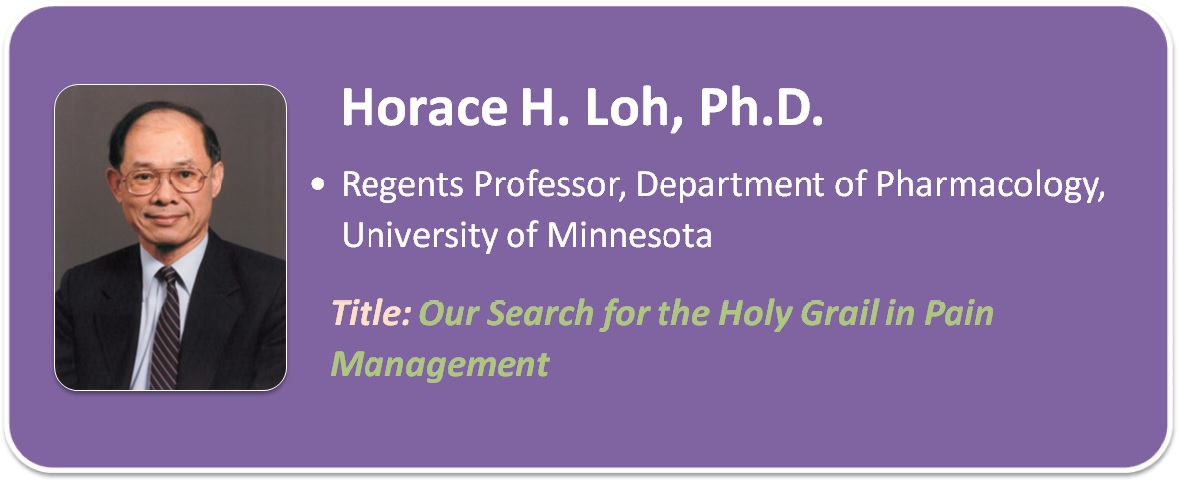
Abstract
It is well known that among all the drugs used in pain management, opioid analgesics are the most efficacious in controlling moderate and severe postoperative pain - but with other accompanying adverse effects such as addiction, there are concerns surrounding the continuous use of opioid drugs. Decades of research have focused on designing an opioid analgesic that has the efficacy of morphine but is devoid of morphine’s adverse effects - to make an “idea analgesic”.
With the cloning of multiple opioid receptors and subsequent gene knockout studies, it is now known that the analgesic action of opioid agonist (such as morphine) is mediated via the μ-opioid receptor (MOR). Opioid antagonists (such as naloxone) which blocks the effect of an agonist via its interact the MOR, but possesses not efficacy by itself.
In our original studies to determine the functional domain of the MOR, we have found that mutation of a conserved in transmembrane region (TM)-4 of all opioid receptors confers full agonistic properties to classical antagonists (PNAS. 93:5715-5719, 1996). In other words, the observed agonists properties by an antagonist was due to the mutations of the conserved serine to leucne (or ala) in the fourth TM domain (S196L). To determine the pharmacological significance of this mutation, in vivo, we have used homologous recombination gene-targeting strategy and we have introduced the MOR-S196A mutants into the mouse MOR gene by a knock-in strategy. In the homozygous mice, opioid antagonists such as naloxone, naltrexone elicited antinociceptive effects same as the agonists. More importantly, chronic treatment of these mice with antagonists, while still killing pain, did not produce the expected tolerance and physical dependence that was observed with chronic morphine treatment. (PANS.100: 2117-2121, 2013)
In order to test the feasibility of utilizing such receptor mutations in the treatment of chronic pain; our recent works have shown some preliminary success by using gene therapy approaches. Using a well-defined delivery vehicle, we are able to see the expression of this mutant receptor in the nociceptive neurons of the proper segment of the spinal cord. By systemic administration of opioid antagonists, which devoid of opioid side effects, activation of this mutant MOR occurred while the endogenous wild type MOR were not activated. These results have provided a “proof of principal” that this should be a feasible approach to make an “idea pain killing paradigm” for treatment of chronic pain.
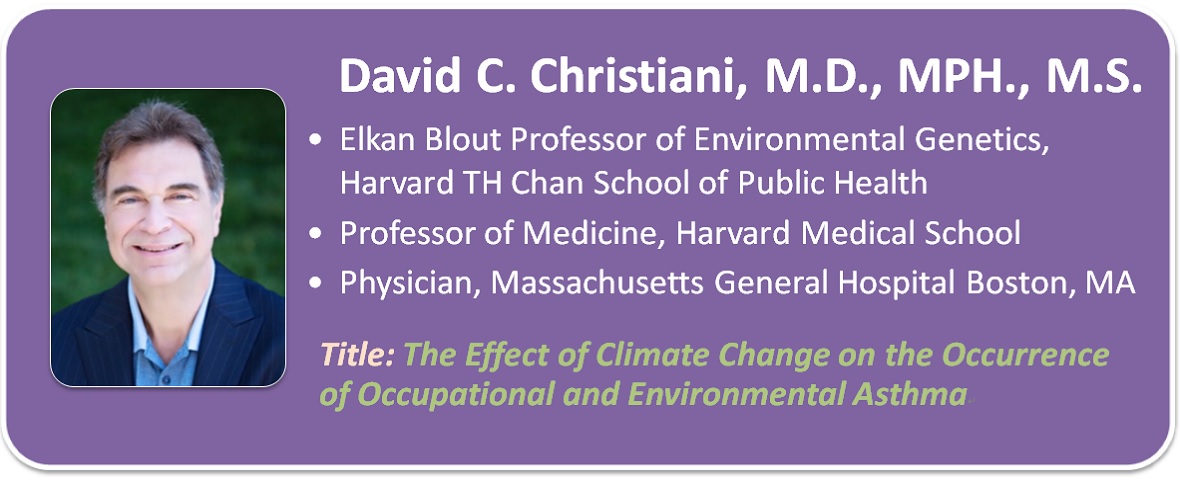
Abstract
Climate change is undeniable based on current science. The major reported health effects associated with climate change have related to changes in infectious diseases, and heat stress. Air pollution is inextricably linked to global climate change, and is known to be associated with lung cancer and COPD, heart disease, vascular and other adverse health effects. A category of lung disease that has not been a focus of climate change research is occupational and environmental asthma.
Occupational and environmental respiratory disease significantly impact work productivity and overall health. In this presentation, I will present how climate change leads to increased exposure to airborne irritants; leads in some areas to increased exposure to aeroallergens; and may amplify the health effects of exposure to respiratory asthmagens.
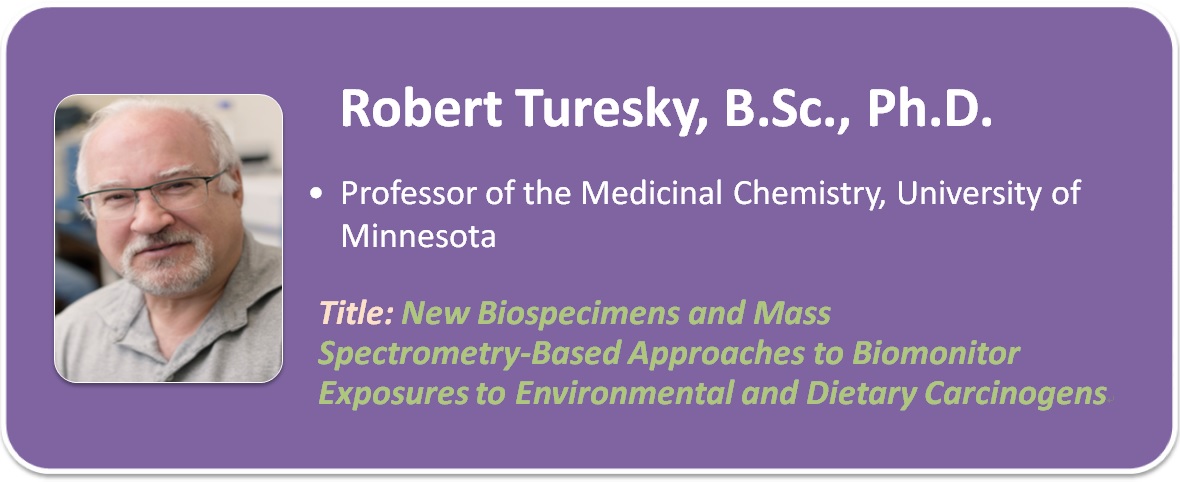
Abstract
Long-term exposures to environmental toxicants and endogenous electrophiles are causative factors for human diseases including cancer. The adduction of such chemicals or their reactive metabolites to DNA, alters DNA structure. DNA adducts that escape repair can disrupt cell division, or induce mutations which can lead to the development of cancer. DNA adducts reflect the internal exposure to genotoxicants and an important endpoint for cross-species extrapolation of toxicity data and human risk assessment. Aristolochic acids (AA) and heterocyclic aromatic amines (HAA) are two classes of carcinogens found in the diet that contribute to the etiology of human cancers. In this presentation, we highlight our analytical mass spectrometry approaches to examine biomarkers of these carcinogens in several types of biospecimens in human population studies in Croatia, Taiwan, and the United States.
AA are found in Aristolochia herbaceous plants, many of which have been used worldwide for medicinal purposes for centuries. AA are causal agents of the chronic kidney disease entity termed aristolochic acid nephropathy (AAN) and potent upper urinary tract carcinogens in humans. AAN is endemic in rural areas of Croatia and other Balkan countries where exposure to AA has occurred through ingestion of bread contaminated with Aristolochia. In Asia, the AAN endemic occurs by exposure to AA through usage of prescribed traditional Chinese medicinal herbs containing in Aristolochia. Despite warnings from federal regulatory agencies, traditional Chinese herbs tainted with AA continue to be used world-wide. DNA adducts of AA can be measured, by ultraper-formance liquid chromatography−electrospray ionization/multistage mass spectrometry (UPLC-ESI/MSn) in fresh frozen renal tissue, but also formalin fixed paraffin embedded (FFPE) tissue, an underutilized biospecimen for assessing chemical exposures. We have also shown that exfoliated urinary cells, a non-invasive biospecimen, can be employed for screening of AA-DNA adducts, as an early biomarker of AA-induced urothelial cancer. The frequent detection of AA DNA adducts at high levels combined with the characteristic mutations induced by AA in TP53 and other cancer related genes provides compelling data for a role of AA in upper urothelial tract cancer.
More than 20 HAA are formed during the cooking of meat, poultry, and fish. HAA are multi-site carcinogens in rodents and though to contribute to human colorectal, pancreas and prostate cancers. We have characterized the major pathways of HAA metabolism and their DNA adducts. Robust biomarkers of exposure have been established for measurement 2-amino-1-methyl-6-phenylimidazo[4,5-b]pyridine (PhIP), the most mass-abundant carcinogenic HAA formed in well-done cooked meats, by measurement of PhIP accrued in human hair, and covalent adducts of its reactive metabolites formed with serum albumin and prostate DNA, by UPLC-ESI/MS3 and high resolution accurate mass spectrometry approaches. Our data show that PhIP is frequently detected in scalp hair of omnivores. About a third of the prostate cancer patients examined thus far form DNA adducts with PhIP in prostate. These preliminary biomarker data provide support to the epidemiological observations implicating PhIP as a DNA-damaging agent that may contribute to the etiology of prostate cancer.

Abstract
Diabetes in pregnancy (or maternal diabetes), whether gestational or pre-gestational (type 1 or type 2), results in offspring with a 2- to 5-fold greater risk of acquiring various debilitating diseases in adulthood − e.g., diabetes, obesity, cardiovascular disease, hypertension (HTN) and chronic kidney disease (CKD). The mechanisms of such “perinatal programming” or “developmental origins of health and disease” – in which the intrauterine milieu is linked to later changes in offspring – are poorly understood.
Congenital renal abnormalities account for 40% of childhood kidney failure cases. A diabetic environment in utero is postulated to alter the gene expression profile in developing kidneys and programs progeny for CKD and HTN in adulthood. While substantial research efforts have established epidemiological correlations between maternal diabetes and these debilitating diseases in progeny, much less is known about their molecular basis.
Since 2004, we have been studying the molecular mechanisms of that maternal diabetes constitutes an adverse in utero environment resulting in impaired kidney formation in progeny and subsequent CKD and HTN in adulthood in these affected progeny. We have identified several factors and/or pathways that are intimately involved, such as dysregulation of the intrarenal renin-angiotensin system (RAS), elevation of oxidative stress, activation of NF-kB (p50/p65), p53, hedgehog interacting protein (Hhip) and TGFβ1 signaling etc.,.
In summary, with the rising incidence of diabetes in pregnancy due to the changing environment, better understanding the biochemical basis of maternal diabetes-induced perinatal programming and identifying key players and/or novel biomarkers, will lead to provide more specific and much-needed therapeutic targets, and, ultimately, effective interventions to combat the cardio-metabolic complications in children of diabetic mothers.

Abstract
Introduction: Upper northern Thailand has topographical feature of basins and high mountains. Chiang Mai City is inevitably retained and accumulated air pollutants as the City located in Chiang Mai-Lamphun Basin. Due to global need of feed corn, massive corn cultivation is not only destroyed the highland forest but also deteriorating ambient air quality from open biomass-burning (BB) of crop residues. First smoke-haze pollution in upper northern Thailand was in March 2007. Health risk among vulnerable subgroups over this BB air pollution is seriously concern.
Objectives: We propose to present ambient particulate matters (PM10, PM2.5) from urban-no BB and rural-BB areas and their chemical compositions; urinary 1-hydroxypyrene (1-OHP) as a biomarker of exposure to polycyclic aromatic hydrocarbons (PAHs) among young children; and preliminary result of a small cohort of chronic obstructive pulmonary disease (COPD) patients from the community hospital in the area with intensive BB activity.
Methods: PM10 and PM2.5 concentrations in urban area were obtained from air quality stations while in the remote areas were collected using MiniVol (Airmetrics, USA). PM-bound PAHs from quartz filters were analyzed using GC-MS (Agilent, USA). The study protocols were reviewed and approved by the Research Institute for Health Sciences Human Experimentation Committee, Chiang Mai University. Concentrations 1-OHP in urine samples were analyzed using HPLC-Fluorescence (HP1100, USA).
Results and discussion: Concentrations of 24-h average PM10 in no-BB months (August to September) are within WHO guideline (50 µg/m3) but in BB months (January to April) were exceeded WHO and Thailand standard (120 µg/m3) for several folds. During smoke-haze episode, the 24-h average concentrations of PM2.5 were about 60-80% of PM10. During BB months, the PM10 concentrations in rural areas were rapidly increasing and contributed to smoke-haze pollution over upper northern Thailand. PM10-bound PAHs (total 16PAHs) concentrations during smoke-haze pollution were up to 16 ng/m3 while in no pollution (background concentration) were lower than 2 ng/m3. Carcinogenic PM10-bound PAHs were highly increased in BB months (59-67% of total PAHs). Urinary 1-OHP concentrations among kindergarten children (4-7 years old) during BB months were significantly higher than those in no-BB months; geometic means were 1,435 (n=373) vs. 935 (n=93) ng/g Cr, respectively. Urinary 1-OHP concentration among 6-11 years old (2011-2012) from US NHANES report (2015) was 187 ng/g Cr. A small cohort of COPD patients (n=52) was enrolled in 2015 at Debaratana Vejjanukula Hospital, Mae Chaem District, 150 km southwest of Chiang Mai City. Mae Chaem is one of intensive BB areas of Chiang Mai Province. COPD patients were found increased acute exacerbation and hospital admission during the BB months.
Conclusions: BB air pollution in upper northern Thailand was seasonally occurred in February to March since 2007. During smoke-haze episode, proportion of PM2.5 to PM10 was significantly increased and concentrations of PM10-bound PAHs were also increased. Upper northern Thai population living in rural areas where having BB activity, had increased urinary 1-OHP, and COPD patients had increased acute exacerbation and hospital admission. Health impact from exposure to smoke-haze pollution from BB sources warrant further investigation.
Keywords: Biomass-burning, smoke haze, air pollution, health risk, children, COPD, Thai population
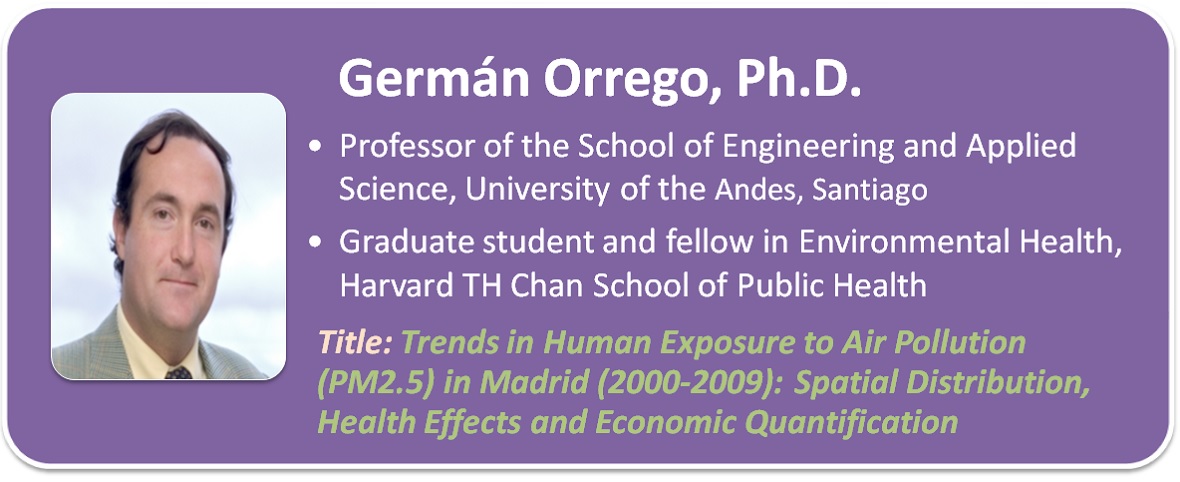
Abstract
This project shows the exposure of the population of Madrid (Spain) to the fine particulate matter (PM2,5) during 2000 and 2009. The method used is the Damage Function, quantifing the environmental concentrations, human exposure, impact on health (premature deaths) and social costs.
Geographical Information Systems (GIS) are used which allows analysis with a high geographical resolution (grids smaller than 1 km2). The annual average concentration of PM2,5 in each station of monitoring was used for interpolate in all the area of study. Kriging was used as interpolation technique, after a Cross Validation analysis in which nine mathematical methods of interpolation were compared.
This project is also based on epidemiological studies relating air pollution with the health of the population (premature deaths). For this, the renowned and internationally cited study of Pope et al. (2002) was used: “Lung cancer, cardiopulmonary mortality and long-term exposure to fine particulate air pollution”.
The economic value of these premature deaths has been valued by multiplying the number of those deaths by the Value of a Statistical Life (VSL). The reference value used is €1,3 million euros (currency value of 2009) per life, corresponding to the official value for Spain (Abellán, Martínez et al., 2011).
It was concluded that the worst of these ten years of study in the Comunidad de Madrid was 2004. This considers social costs for not following the recommendation of the “WHO - World Health Organization” (OMS) of 10 [μg/m3] for every € 2.795,4 million (euros of 2009) with a confidence interval of 95% (CI) [€ 968,1 - € 4.894,3]. And for not fulfilling the standards of the “EPA - Environmental Protection Agency” (EPA) of 15 [μg/m3] at that time for € 1.376,5 million for a CI 95% [€ 472,5 - € 2.435,9]. Finally, for not respecting the specifications of the “EU - European Union” (UE) of 20 [μg/m3] a cost of € 128,7 million with a CI 95% [€ 43,9 - € 229,0].
It was also found that during 2004 the Municipios that were the most affected were the Ayuntamiento de Madrid, Alcalá de Henares, Leganés and Getafe. And within the Ayuntamiento de Madrid, the neighborhoods of Ventas, Pueblo Nuevo, Aluche and Embajadores.
As an average of these 10 years (2000-2009) in the Comunidad de Madrid, the yearly social costs for not following the recommendation of the WHO have been € 1.955,7 million with a CI 95% [€ 674,4 - € 3.441,7]. And for not fulfilling the standard of the EPA € 647,8 million with a CI 95% [€ 221,7 - € 1.150,5]. Finally, for not respecting the target standard of the UE, a cost of € 19,3 million with a CI 95% [€ 6,6 - € 34,3].
Finally, we may conclude that the quality of the air in Madrid by PM2,5 has been improving considerably in these last years. Nevertheless, there are still targets to be achieved as the costs of disregarding the recommended standards have been high.
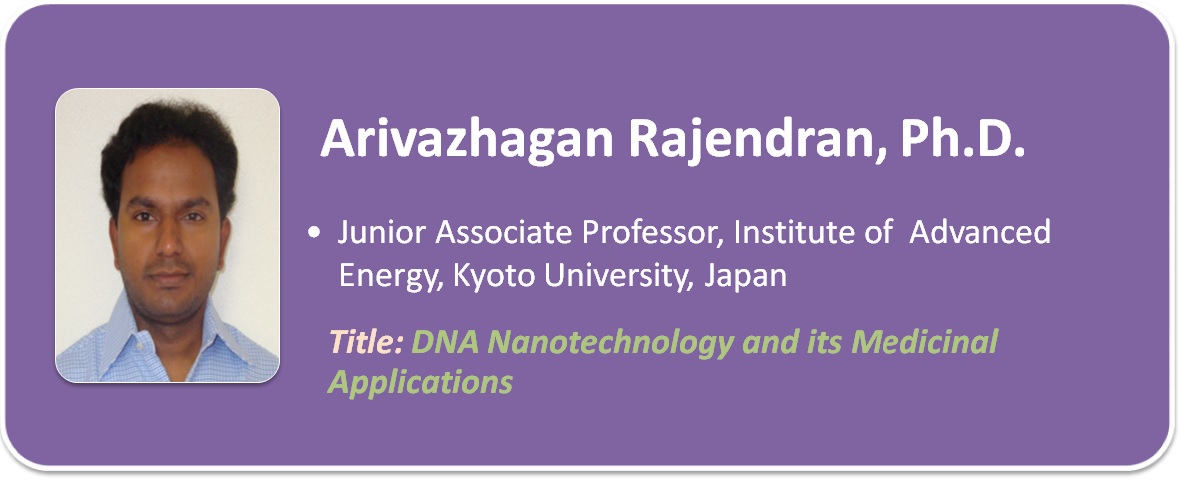
Abstract
Numerous research efforts have been made to understand the effect of environmental factors on human health, particularly for the cause of cancer. All cancers are originated from the combined effect of environmental factors and genetic mutations, meaning that the risk of cancer increases by the genetic modifications caused by the exposure of environmental carcinogens. The identification of environmental carcinogens, cancer screening, diagnosis, and drug development are current topics of interest. Here, I report on the development of novel method based on the structural DNA nanotechnology for the screening of cancer drug molecules. Structural DNA nanotechnology has attracted much attention since the recent development of the “scaffolded DNA origami”- a method to fold DNA into any arbitrary two- and three-dimensional structures.1 This method has been successfully utilized for the preparation of various templates for the nanopatterning of proteins, nanoparticles and other functional components, analysis of non-canonical DNA structures and their intermediates, and enzymatic reactions.
At first the drugs targeting the specific sequence and structure of DNA was investigated. Guanine-rich chromosomal telomeres are the potential targets for the cancer drug development. These sequences form the non-canonical G-quadruplex structures. The drugs that bind to the quadruplex structures are thought to interfere with telomere structure, elongation, capping, replication, genomic stability, oncogene expression, and to exert control over cancer cell proliferation. The G-rich DNA was incorporated inside a DNA origami frame and the drug-induced structural changes to form a G-quadruplex was investigated. Further, the mechanism of the G-quadruplex folding was also directly visualized. The mechanism of action of the drug molecule was studied in detail.2
As for the protein targets to develop the cancer drugs, the function of the topoisomerases (Topos) was investigated. During DNA replication and transcription, overwinding of the DNA duplex occurs. If it is not relaxed, it eventually stops the ability of the enzymes involved in replication process. Topos control these topological conditions by transiently cleaving the phosphodiester bond, which generates a Topo-DNA cleavage complex. Once the winding stress is resolved, the enzyme-mediated DNA break is resealed. This process is critical for the healthy cells to survive, and failure to reseal the DNA break can ultimately lead to cell death. This Topo-DNA cleavage complex and various other steps involved in the Topos function are of great interest as potential targets for the development of anticancer drugs. In this work, a novel method was developed by the combination of DNA origami and high-speed atomic force microscopy3 for the screening of Topo-inhibitors. As for the target structures for the Topo reactions, we have constructed topologically interlocked DNA catenane- and rotaxane-like structures inside a DNA origami frame. The Topo reactions on these functional structures were investigated. The screening of Topo inhibitors are under investigation.
References
1. P. W. K. Rothemund, Nature, 2006, 440, 297.
2. A. Rajendran, M. Endo, K. Hidaka, P. L. T. Tran, M.-P. Teulade-Fichou, J.-L. Mergny, H. Sugiyama, RSC Adv., 2014, 4, 6346.
3. A. Rajendran, M. Endo, H. Sugiyama, Chem. Rev., 2014, 114, 1493.
Domestic Speakers
(依演講順序)
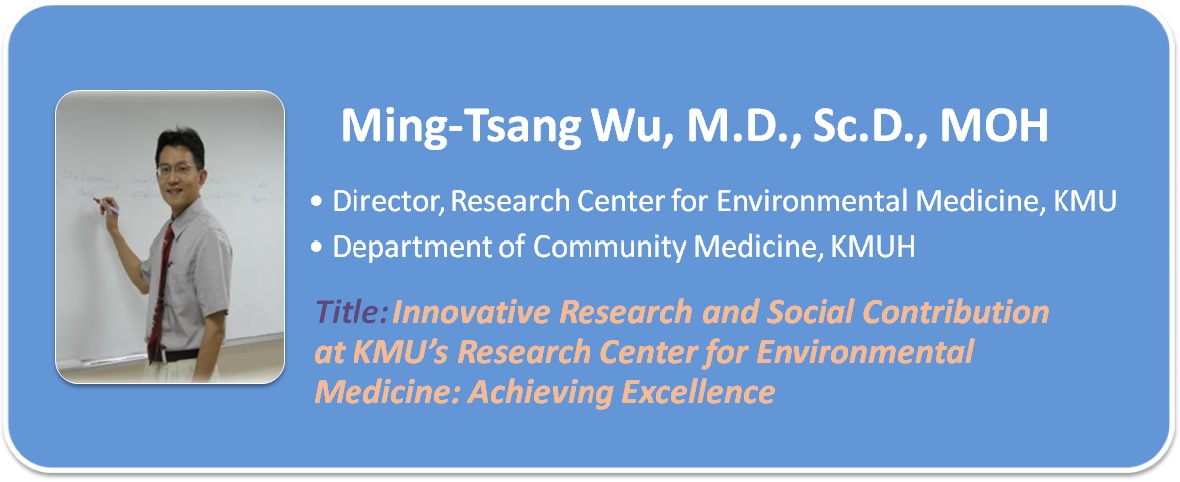
Abstract
The mission of the Research Center for Environmental Medicine is to become a first rank research center dedicated to the study of the world’s important environmental and occupational medicine concerns. Under the continuous grant support from Kaohsiung Medical University (KMU) in the past three years, the Center has established several interdisciplinary research teams and created some unique analytical platforms to investigate and clarify the adverse effects of emerging environmental hazards such as phthalates and melamine on health and devise strategies for meeting these public health challenges. In this talk, I will briefly introduce the history of the Center and its current research activities.

Abstract
Food additives are used for processed food to aid manufacturing process, maintain product quality, flavor, appearance, to facilitate food distribution and other purposes. Therefore it is undeniable that food additives have played a crucial role in the food industry. With the focus on food additives due to increasing food incidents, food additives have unfortunately been misperceived by the consumers and media as harmful toxic chemical substances.
The Act Governing Food Safety and Sanitation is the basic but most important law for food safety management in Taiwan. The use and application standards of food additives must follow the “Standards for Specification, Scope, Application and Limitation of Food Additives” according to article 18 of the Act. This standard is based on a positive list. Therefore, any substance not on the list is not permitted to use as food additive. In addition, the specifications of food additives must comply with the standards, in order to control the identity and purity of each substance.
Several policies including permit documents of food additives, mandatory information registration, traceability system, labeling requirements, manufacturing separation, certification of sanitation and safety management systems and self-management responsibility of the food industry have been taken into force by the government, in order to fortify the controls on food additives and increase the confidence on food safety.
We all share responsibilities of food safety, including government, the food industry and the consumers. With the supervision and the management taken by government, the good self-management established by the food industry, and consumers with knowledge and rationality, food safety will be better in Taiwan.
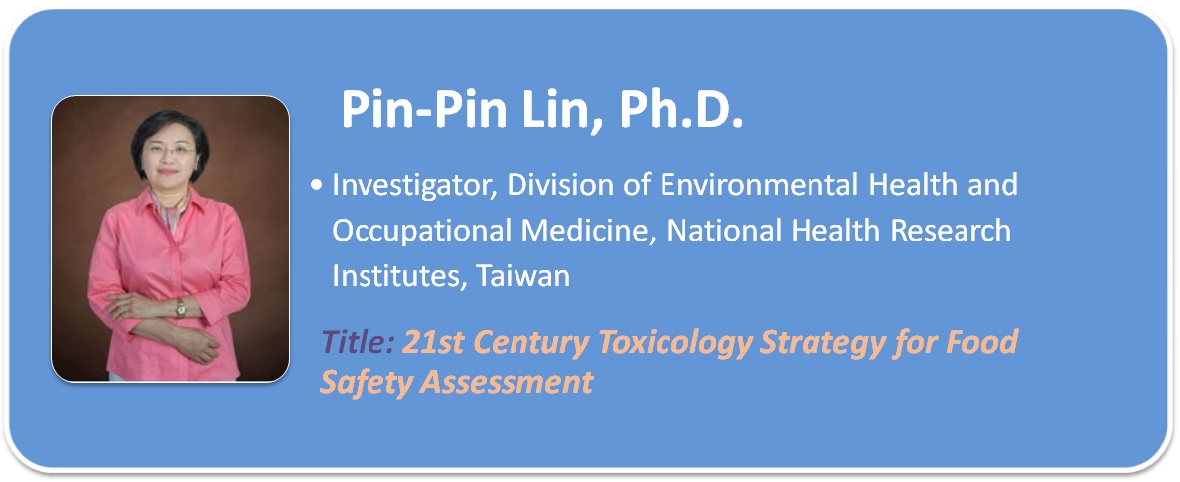
Abstract
Toxicology information based on animal studies is the only criteria for ensuring food safety when human data is unavailable. However, animal toxicity information is limited for many chemicals currently present in food. While thousands of chemicals are directly added to or contact with food, many of which have undergo little or no toxicological evaluation. Thus, it is necessary to address new techniques for accurate and efficient toxicity testing, offering a time- effective, cost-effective and human-relevant platform for the evaluation of large chemical libraries. Twenty first century toxicity strategies are primarily based on in vitro and in silico methodologies that evaluate changes in biological processes at the molecular, cellular, and tissue levels. These strategies include a combination of expert’s knowledge, significant biomarkers and predictive computational models based on chemical structures, read-across, quantitative structure–activity relationship, high-throughput screening method or physiologically based pharmacokinetic model. This strategy is not only to be able to enhance the scientific basis of risk assessment but also to resolve species extrapolation and population variability. These integrated approaches highlight human relevance of test results compared to traditional toxicological testing, providing a future vision and strategy in the food safety assessment.

Abstract
Certain phthalates have adverse effects on male reproductive functions in animals, and they potentially affect human testicular function, including steroidogenesis and spermatogenesis, but the results debated yet and little is known about the active mechanisms in adult males. We measured the biomarkers of phthalate exposures and explored the associations between reproductive hormones balance, insulin-like factor 3 (INSL3) secretion and semen quality in adult men. Urine, blood, and semen samples were collected from the male partners of infertile (n = 253) and fertile (n = 37) couples who presented to a reproductive center in southern Taiwan between 2010 and 2014. Plasma levels of INSL3, reproductive hormones, semen-quality parameters, and 11 phthalate metabolites in urine and semen were measured. There were significant correlations in the distribution pattern of phthalate metabolites (mono-ethyl phthalate [MEP] and di-2-ethylhexyl phthalate [DEHP] metabolites) in urine and semen. In adjusted regression models, increases in urinary phthalate metabolites levels were adversely associated with TT (DEHP metabolites), the TT: LH ratio (DEHP metabolites), INSL3 (monobenzyl phthalate [MBzP], mono-2-ethylhexyl phthalate [MEHP] and MEHP%), sperm concentration (MBzP, MEHP and MEHP%) , motility (MBzP and MEHP) and normal morphology (MEHP%); but were positively associated with estradiol (E2, DEHP metabolites), the E2: TT ratio (mono-methyl phthalate [MMP], MEP and DEHP metabolites) and SHBG (DEHP metabolites) (all p < 0.05). Higher seminal phthalate metabolite levels were associated with increases in LH (MEHP), SHBG (Mono-2-ethyl-5-hydroxyhexyl phthalate), inhibin B (MBzP) and the E2: TT ratio (MEHHP) as well as decreases in the Inhibin B: FSH ratio (mono-iso-butyl phthalate and mono-2-ethyl-5-carboxypentyl phthalate), sperm concentration (MMP and DEHP metabolites), motility (MEP and DEHP metabolites), normal morphology (MEP) and INSL3 (MMP and MEP) (all p< 0.05).The significant and monotonic trends in semen volume, sperm concentration, and sperm motility were also associated with increasing quartiles of INSL3 levels (all Ptrend< 0.001). Our data suggest that INSL3 secretion, reproductive hormone balance (especially TT and E2), and sperm production and quality might be simultaneously adversely affected in individuals excreting increasing levels of phthalates metabolites (especially butyl benzyl phthalate and DEHP) in urine and semen samples. Therefore, our findings support the need for additional research on the reproductive effects of endocrine disruptors in adult males.
Keywords: Biomarkers, Phthalate metabolites, Reproductive hormones, Insulin-like factor 3, Semen quality, Testicular function, Leydig cell
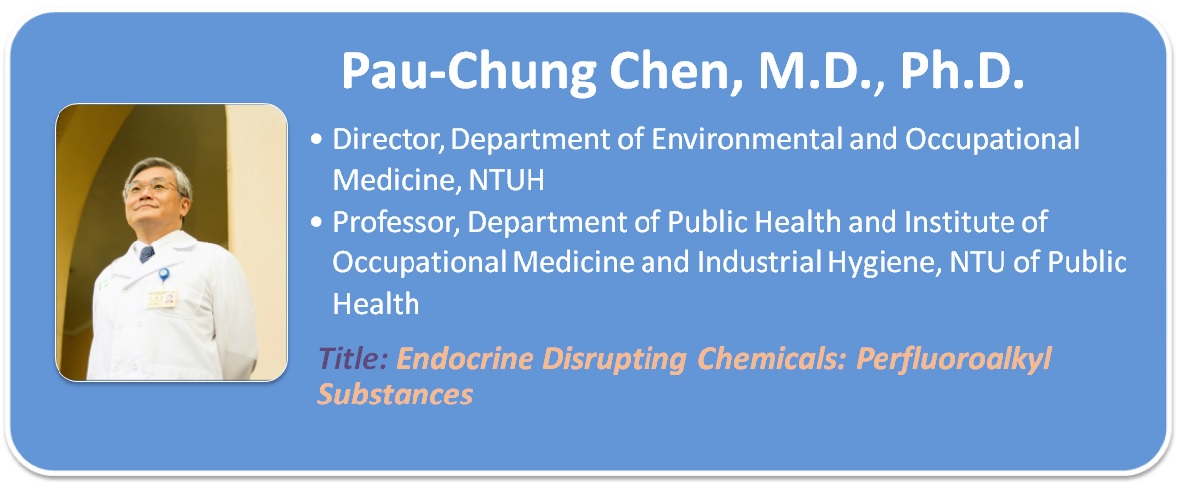
Abstract
Perfluoroalkyl substances (PFASs), one class of endocrine disrupting chemicals, consist of a backbone typically 4 to 14 carbons in length and a charged function moiety. These compounds have been used in a variety of consumer and industrial applications since 1950. Health concerns for PFASs include hepatotoxicity, developmental toxicity, immunotoxicity, hormone disturbances, and tumorigenic potential. Our data from the Taiwan Birth Panel Study suggest inverse associations between perfluorooctane sulfate (PFOS) levels in umbilical cord blood plasma and birth outcomes and gross and fine motor development. Prenatal PFOS and perfluorooctanoic acid (PFOA) exposures positively correlated with cord blood IgE levels. In the Genetic and Biomarkers study for Childhood Asthma, we found that positive associations between serum PFASs and asthma, and positive associations between PFASs and IgE, absolute eosinophil counts (AEC), and eosinophilic cationic protein (ECP) levels, and asthma severity scores in asthmatic children. In the Taiwan Adolescent Panel Study, higher serum concentrations of PFOS were associated with an increase of carotid artery intima-media thickness in adolescents and young adults. In conclusion, exposure to lower levels of PFASs can pose significant hazards to children’s health. Mechanistic research is needed to elucidate causal relations.
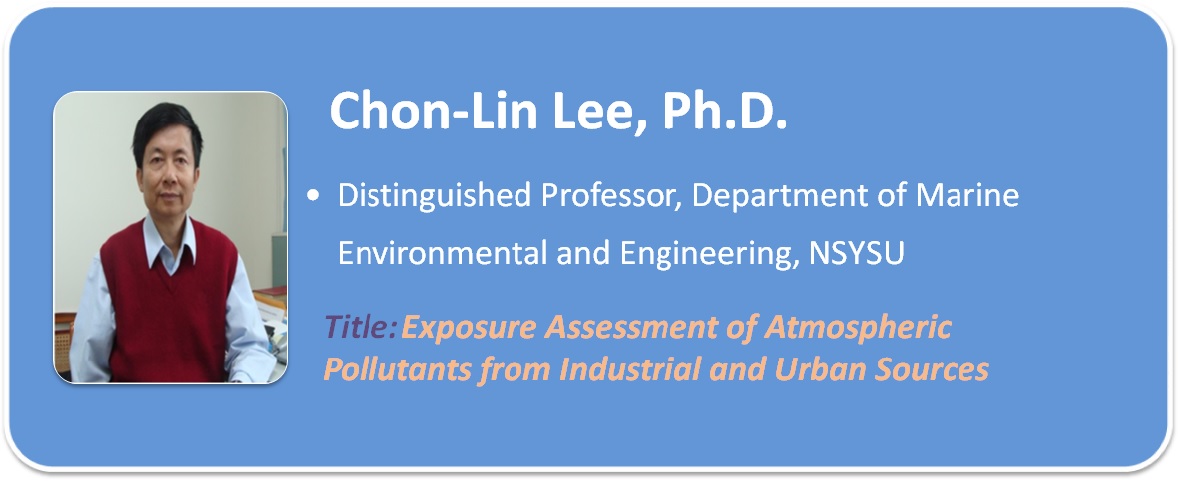
Abstract
Atmospheric pollution especially PM2.5 has been a social focus as its direct impacts on human health. Epidemiological and toxicological studies have demonstrated that PM2.5 can increase the mortality and morbidity of respiratory and cardiovascular diseases, as well as lung cancer, asthma, and chronic obstructive pulmonary disease. Exposure to air pollutants, such as PM2.5, PM2.5-PAHs (polycyclic aromatic hydrocarbons), PM2.5-metals, and volatile organic compounds (VOCs), could result in harmful or irreversible effects on human health. However, among these pollutants, there are only hourly PM2.5 data are available in certain stations in Taiwan.
Several modeling approaches have been developed for simulating ambient PAHs, but no hourly intra-urban spatial data are currently available. A new grid-scale model was developed to simulate PM2.5-PAH levels, on hourly basis, in a highly industrialized city Kaohsiung. The PM2.5-PAHs were simulated by the air quality data from Environmental Protection Administration. Multivariate linear regression models, in combination with correlation analysis and PAH source identification by principal component analysis (PCA), were performed to simulate hourly grid-scale PM2.5-PAH concentrations, taking criteria pollutants and meteorological variables selected as possible predictors.
A geographic information system (GIS) was used to visualize spatially distributed PM2.5-PAH concentrations of the modeling results. This new grid-scale modeling strategy, incorporating the output of simulated data by GIS, provides a useful and versatile tool in personal exposure analysis and in health risk assessment of air pollution. Combined with other models for PM2.5-metals and VOCs, a comprehensive exposure assessment of atmospheric pollutants, such as PM2.5, PM2.5-PAHs, PM2.5-metals, and VOCs, could be evaluated for every resident living in the city. Moreover, the source identification of those pollutants could hint where they came from, industrial output, local sources, or long-range atmospheric transport.
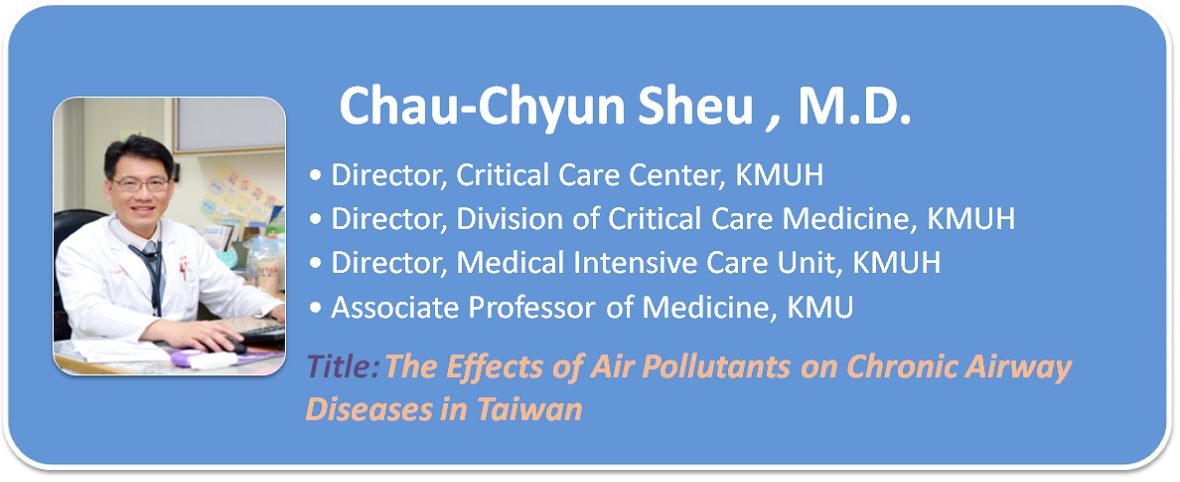
Abstract
According to the statistics by World Health Organization (WHO), around 300 million people suffer from asthma and 200 million people suffer from chronic obstructive pulmonary disease (COPD) worldwide. The population of chronic airway diseases including asthma, chronic bronchitis, emphysema, COPD, bronchiectasis is still increasing. In Taiwan, chronic airway disease has become an increasingly important public health issue. According to the statistics by the Bureau of National Health Insurance, the annual expenditures on asthma and allergic rhinitis reached a total of 4 billion dollars (TWD). Although the causes of increased chronic airway diseases incidence remain unclear, it is believed that the increased exposure to noxious agents, such as ambient air pollutants, chemical fumes, tobacco smoking or dusts, may play an important role.
To understand the influence of air pollutants on chronic airway disease, we analyzed the longitudinal data from Environmental Protection Administration (EPA) and National Health Insurance Research Database (NHIRD). We evaluated the effects of individual air pollutants, including PM 2.5, PM 10, ozone, SO2, NO, NO2, and CO on prevalence, disease progression, healthcare resource utilization of chronic airway diseases. We also took the effects of temperature, humidity, and seasonality into consideration. The results of this longitudinal, country-wide study will provide us a better understanding of the associations between air pollution and chronic airway disease in Taiwan.
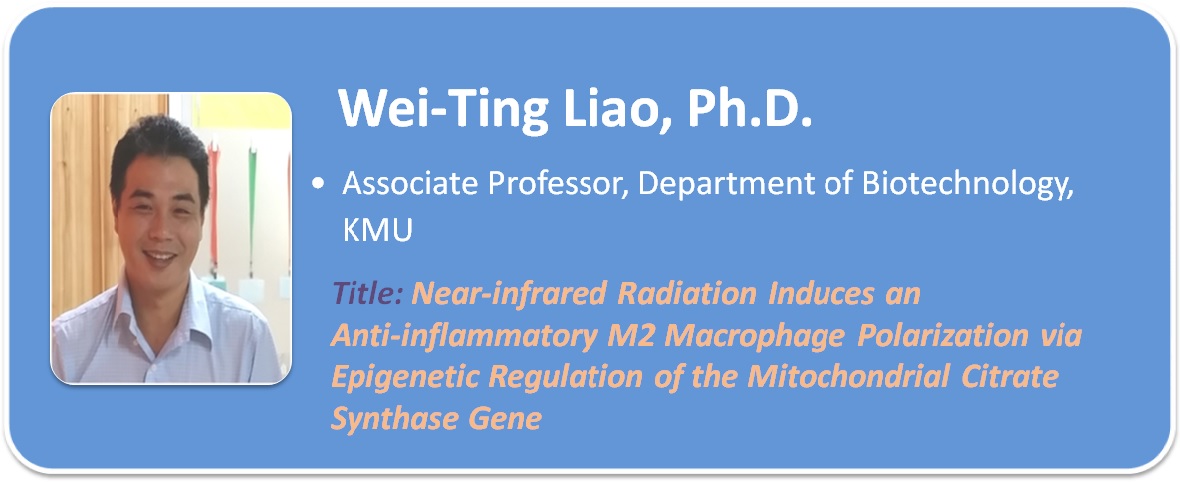
Abstract
Global warming is caused by infrared (IR) radiation and related heat trapped in the atmosphere. However, little is known about the impact of global warming on human health. In this study, we investigated the effects of near-IR (NIR) on macrophages. Proteomic analysis revealed that NIR radiation enhanced the expression of citrate synthase (CS) in THP-1 cell line. The increased CS protein expression was triggered by NIR-induced histone-3-lysine-4 (H3K4) hypermethylation on the CS gene promoter, but not by heat. NIR-induced CS expression promoted macrophage M2 polarization. These M2-like macrophages induced TGF-β1 which was released from CD4+ cells. These mechanistic regulations were validated in mouse models. Furthermore, NIR irradiation showed significant anti-inflammatory effects, including decreased redness and swelling, with a higher TGF-β1 and lower pro-inflammatory cytokine TNF-α level in PMA-induced mouse skin inflammation. These findings provided an evidence-based impact on human health under climate change. In parallel, NIR may be beneficial in the development of anti-inflammatory treatments.

Abstract
Desorption electrospray ionisation mass spectrometry (DESI-MS) is an emerging analytical technique that enables in situ mass spectrometric analysis of specimens under ambient conditions. It has been successfully applied to a large range of forensically relevant materials. The minimal specimen preparation required for analysis and the sensitivity of detection achieved offer great advantages, especially in the field of forensic science. In our experience, liquid-liquid extraction (about 30 minutes) or solid-phase extraction step had to be carried out before analysis by DESI-MS/MS in order to obtain detection levels that satisfied the doping control requirements. Indeed, suppression effects caused by the complicated urine matrix were minimised by solid-phase extraction in literatures. To achieve high accuracy and sensitivity in liquid chromatography mass spectrometry and gas chromatography mass spectrometry, samples of biofluids need to be carefully prepared. Here, we presented our experience by DESI mass spectrometry in drug abuse evidence and four real drug abuse cases including new psychoactive substances in urine by the young adults and youngsters from our Emergency Department, Kaohsiung Medical University Hospitals. We also compared our DESI mass spectrometry findings with traditional investing methods, such as liquid chromatography tandem mass spectrometry.
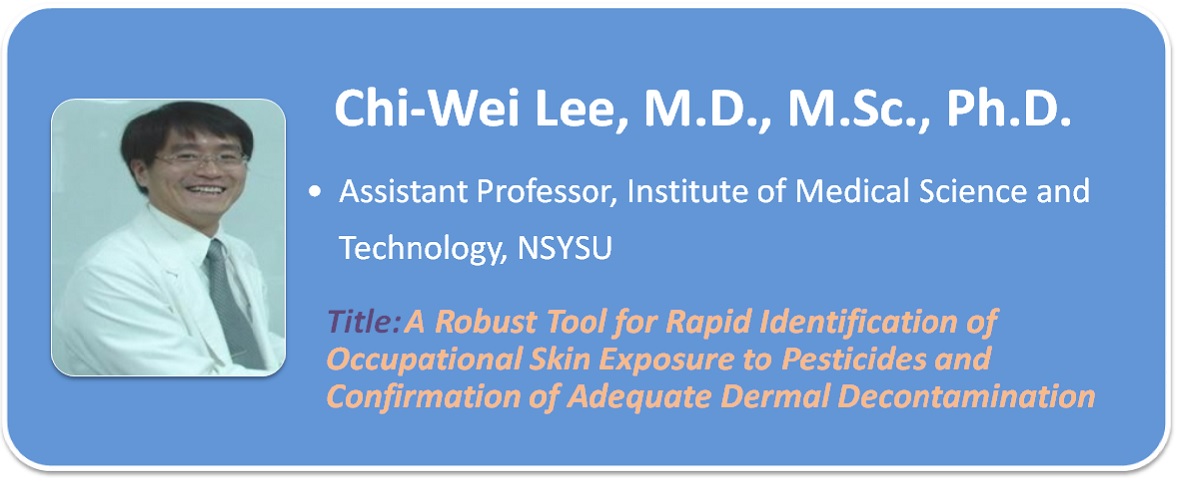
Abstract
Dermal exposure to pesticides may cause severe intoxication and even fatal outcome. To expedite rescue in the emergency department, it is mandatory to develop a point-of-care analytical method for immediate identification of pesticides on the skin of exposed personnel, and to perform immediate dermal decontamination to optimize the chance of full recovery. Unfortunately, there is currently no efficient way to identify immediately the contaminating pesticides on skin and to determine when a patient is “sufficiently clean” after dermal decontamination. In this study, some of the most commonly used highly toxic pesticides that contaminate and permeate the skin were analyzed by ambient mass spectrometric technique. It is used to confirm the adequacy of pesticide decontamination from the skin. Pesticides diluted to different concentrations were sprayed on the surface of swine skin (a well-documented analogue to human skin) nakedly exposed or covered underneath four different kinds of fabric commonly worn by field workers. A metallic probe was used to transfer the analytes to the thermal desorption-electrospray ionization unit for subsequent mass spectrometric analysis. The turnaround time took less than 1 min. The limits-of-detection for these pesticides on the skin surface nakedly exposed or covered underneath different fabrics were found to be at sub-ppm levels. The technique was also tested for its efficacy in confirming adequate pesticide decontamination from skin. Since the whole analytical process is extremely fast, it allows for (1) early point-of-care identification of contaminating pesticides on skin of patients in the emergency room, as well as, (2) rapid confirmation of adequate decontamination. Both of which provide crucial toxicological information for decision-making during emergency care.
2014 © 高雄醫學大學 精準環境醫學研究中心
建議使用 Chrome / Safari / Firefox 瀏覽
- 校址:高雄市三民區十全一路100號 國際學術研究大樓 6樓
- 電話:07-3121101 ext. 2318 (行政辦公室/實驗室)
- 信箱:envmed@kmu.edu.tw

